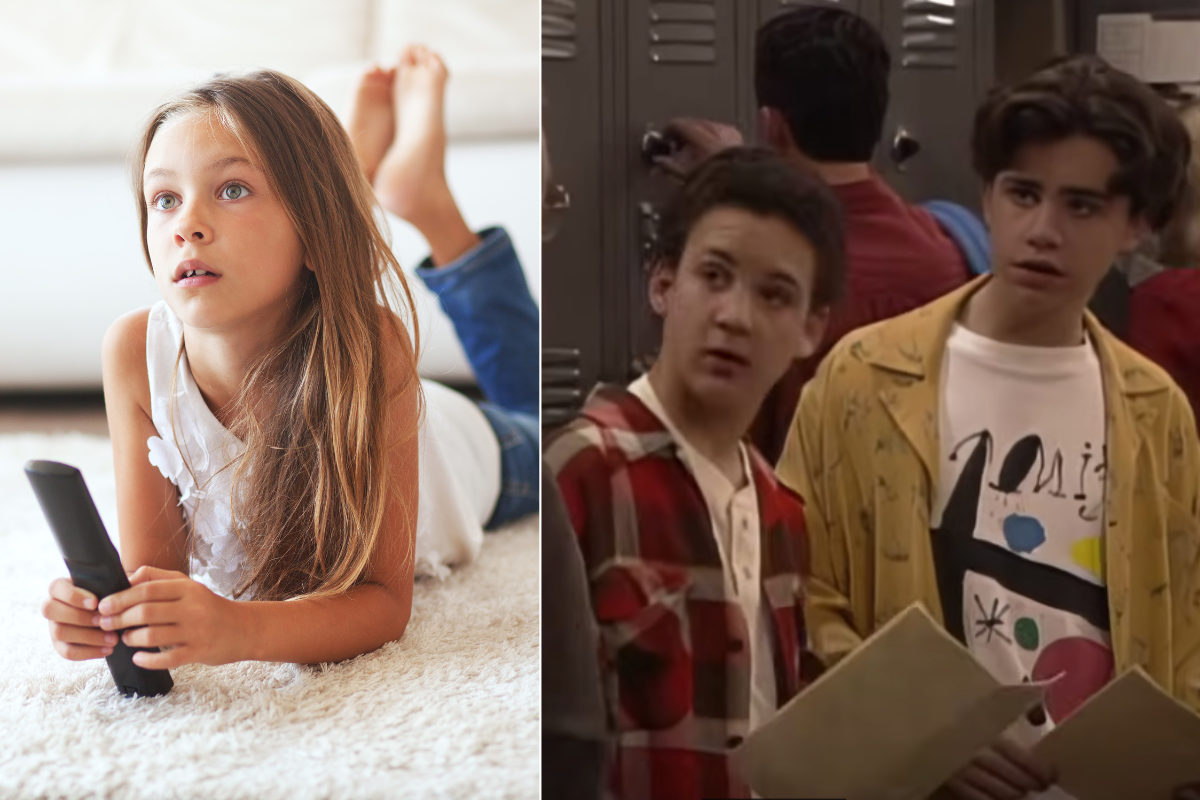I forced my Gen Alpha kid to watch 22 episodes of 'Boy Meets World.' Then she asked for more.
This one still delivers.

Young girl watching TV,; Cory and Shawn from Boy Meets World
TGIF can mean a lot of things to a lot of people. A celebration of the fact that the weekend is just around the corner, a pretty solid casual restaurant or happy hour spot from the early 2000s, etc. But to elder millennials, TGIF refers to only one thing: an epic evening of television featuring iconic sitcoms like Full House, Family Matters, Perfect Strangers, and of course, Boy Meets World. Can you believe those bangers used to all be on back to back to back?! We truly didn't realize how lucky we were in the 90s.
Boy Meets World, in particular, was an incredibly important show for me. As a curly haired, middle-class kid, it was easy for me to see myself in Cory Matthews, the flawed protagonist of the series. Cory was always worried about fitting in and being popular. He was jealous that his cool older brother and best friend had great hair and knew how to talk to girls. He was constantly screwing up and finding ways to make things right. It's what television was meant to be, and it taught me lessons that I took into my own friendships, my first relationship, and more.
As I get closer to my late-late-late 30s, I decided that I wanted to see if Boy Meets World still had the same magic I remember from when I was young. The twist is that now I have a daughter about Cory Matthews' age, a Gen Alpha kid, and I wanted to see how she'd respond to the characters and storylines that resonated with me so deeply way back when. For reference, a LOT of books, movies, and shows of my youth have completely failed to connect with her and her more modern sensibilities.
So, I sat her down and more or less forced her to watch the first season, or 22 episodes, with me. To my surprise, she wanted to keep going.

Upon rewatch, it's not hard to see why. If you look past the baggy clothes and landline telephones, the lessons (and laughs) underneath are timeless. I was not expecting the show to connect with a representative from Gen Alpha, who are decidedly different from millennials when we were that age, in many many ways. But I think it works not because it reminds her of other things she likes, but specifically because it doesn't.
Here are five things Boy Meets World brings to the table that my 10-year-old is not used to seeing in her media:
1. Lessons (so many lessons)

By the end of every episode of the show, Cory has had to learn a very tough lesson. He has to learn how to be more honest, how to be a better friend, or even when it's good to break the rules.
And that's just the regular episodes, to say nothing of the Very Special Episodes. After much consideration, I say: Bring back Very Special Episodes!
Are they cheesy? Absolutely. Are they a little simplistic and surface level? Sure. But they do something not a lot of kids media does anymore which is challenge young people with complex ideas. They are great discussion starters, especially as a parent watching alongside.
In one episode, Cory and Topanga fall asleep at the school while staying late to finish a project. The next day, everyone at school thinks Cory is "the man" for, presumably, hooking up with her. The show leaves certain things unsaid, or to the imagination, but it gave us a peek into sexism and reputation that my daughter hasn't been exposed to in the usual shows she watches.
And then, of course, there's the famous episode "Cult Fiction" where Shawn joins a cult called The Center. "Daddy, what's a cult?" is not a question I expected to field from my 10-year-old, but here we are! It was challenging, in a good way, to try to explain what they are and why they're harmful, which the show itself only vaguely touches on. These episodes were successful at piquing her curiosity and forcing her to ask questions, which is exactly the point.
A lot of the media my daughter watches just lacks this substance, even if it is simplistic at times in Boy Meets World. Shows she's enjoyed like Henry Danger or Sam and Cat come across as more purely silly—and both receive dismal scores from Common Sense Media for categories like "Positive Messages" and "Educational Value."
2. An honest-to-God plot

Boy Meets World isn't known for convoluted plot twists or reinventing the narrative structure. But at least it's got a story to offer.
Gen Alpha doesn't spend a lot of time engaging with plot-based media. My daughter and her friends love to read, and to watch the films and TV shows based on their favorite books, but as a whole, younger people are getting a lot of their entertainment from YouTube and TikTok. They spend a lot of time watching Get Ready With Me videos, Try Not To Laughs, Mr. Beast stunts, or people playing video games on livestreams.
Maybe it makes me sound old, but I'll say it anyway: Story still matters! Plot is good for your brain because it forces you to put yourself in the shoes of different characters. You have to imagine what one character might be thinking in a scene that leads them to do whatever it is they do next. Characters don't always say exactly what they mean (subtext) so your brain has to fill in the gaps and try to decipher when they're lying or withholding information or their true emotions.
Not all screen time is created equal. Watching a story is an active process. It's important for our brains, and helps build empathy and social intelligence. It elicits emotion. That's definitely something that's missing from a lot of the Gen Alpha media diet.
It also keeps kids like my daughter coming back because she wants to know what's going to happen next, not because the algorithm's got her hooked with easy bursts of dopamine.
3. Extremely outdated references, fashion, and technology

The clothes and the landlines in the show are a serious walk down memory lane, but Boy Meets World feels old in more ways than that. (Seriously, at one point the Matthews family receives a telegram, which was a stretch even for the 90s.)
Boy Meets World, at this point, almost represents a completely different way of life. Shawn carries around a "black book" of all the girls he's dated with their phone numbers written down. The celebrity cameos are completely lost on my daughter, and often on me (I mean, the Love Boat guys, really?). But it's fun to get to explain these aspects of my own childhood to her, and she gets a kick out of it, too. The strange elements are challenging, in a good way.
As a side note: The baggy jeans are the one thing that don't look out of place anymore on the show. They're so back, baby!
4. Brave choices

BMW was not afraid to pull at the heart strings, and while the plot was usually pretty formulaic, the writers were capable of shocking you.
For example, one of the main teachers, Mr. Turner, nearly dies out of nowhere! Shawn's dad abandons him to go chase after the love of his life. And a fresh-out-of-high-school Eric finds himself dating a young, single mom. Of course, one of the most memorable and shocking moments in the show is when Cory cheats on Topanga with another girl on a school trip. Can you imagine that happening in a so-called kids' show today? It's character suicide by today's standards. But they did it anyway and somehow pulled it off. That episode is heavily debated among fans to this day.
The show also played into sitcom tropes and cookie-cutter themes and lessons, but it also wasn't afraid to wade into grey areas sometimes. One of my favorite early episodes of the show to rewatch is an episode where Cory's dad lets him stay up late to watch a big baseball game with him, and a very sleepy Cory flunks a test at school the next day. Cory's dad and teacher, Mr. Feeny, then trade jabs over whether it was right or wrong. There's no clear winner, no exact right answer, just a lot to think about. I like my daughter being exposed to the idea that there's not always a clear cut solution, and I get the sense she's enjoyed that about the show, too.
Boy Meets World, contrary to its squeaky clean reputation, also has a few episodes that Disney has subsequently banned for being too racy or controversial, including Shawn shoving his girlfriend after having too much to drink. I'd like to see any modern family-friendly show have the guts to go there and turn it into a teachable moment.
5. Good adults—mostly

Alan, Amy, Mr. Feeny, and Mr. Turner were anything but caricatures. What strikes me most rewatching as an adult is how much I relate to and still admire the core adults in the show.
Even in a lot of modern adult sitcoms, the adults are all idiots. In kids shows, it's worse, with the buffoon dad merely there for comic relief and the mom too busy and frazzled to have any idea what's going on.
Crucially, during our rewatch of BMW, I realize that every single one of the main adults screws up at some point and has to apologize for it. They do their best, they're mostly wise and responsible, but they make mistakes, too. It's so important for kids to see that, and for my daughter to know that my wife and I are the same way.
Not everything in Boy Meets World has aged well. Even I can admit that the show has its warts.
Cory's behavior isn't always great. He can be very jealous and controlling of Topanga, and there's also this running thread in the show that they are "soulmates" and "absolutely have to be together" under any circumstances. That's an idea we would likely consider harmful or toxic today. Topanga even gives up a chance to go to Yale so that she can go to the state school with Cory, which is probably not the decision I'd like my own kids to make. The boys on the show can also be a little girl crazy, to the point that it borders on misogyny or just plain gross-ness. It also leans so heavily on nerd/jock stereotypes that it ends up perpetuating them.
But the core elements of the show: the lessons, the way it never talks down to the kids watching it, the beautiful portrayals of friendship and first love. Those are absolutely timeless.
There just aren't many shows left that even attempt to do what Boy Meets World did and the way it grew up with its audience. The closest modern equivalent I've seen would have to be Bluey. Maybe that's why the show is so beloved, because it understands what made the TGIF formula work so well and has perfectly adapted it to the modern age. It hits all five of the points above, with admirable adult characters, complex lessons, and even flashbacks to the 80s!
A skeptic might say that my daughter doesn't really care about the show, she just likes getting to stay up late and spend time together. But, now that we're deep into Season Five and showing no signs of slowing down, I can safely say that the magic is still there.
- Gen Alpha vs Millennial slang. Mom and son do amazing rapid fire comparison round. ›
- 'What on Earth is a GYAT?' Millennial feels ancient after learning the latest Gen Alpha slang ›
- Therapist that coined 'honey badger generation' for Gen Alpha explains why it's perfect ›
- Language expert gives incredible speech to high school students using only Gen Alpha slang ›
- Boomers and Gen Xers share favorite Gen Alpha and Gen Z slang - Upworthy ›





 A Ferris Buellers Day Off Film GIF
A Ferris Buellers Day Off Film GIF Cameron GIF in Ferris Buellers Day Off 80S
Cameron GIF in Ferris Buellers Day Off 80S A cat and dog cuddle on the floor. Photo by
A cat and dog cuddle on the floor. Photo by  A bored cat files its nails.
A bored cat files its nails. People who write their lists by hand might be able to remember them better.
People who write their lists by hand might be able to remember them better. Writing your list by hand could curb impulse shopping.
Writing your list by hand could curb impulse shopping.  Digital lists are perfect for collaborations. P
Digital lists are perfect for collaborations. P